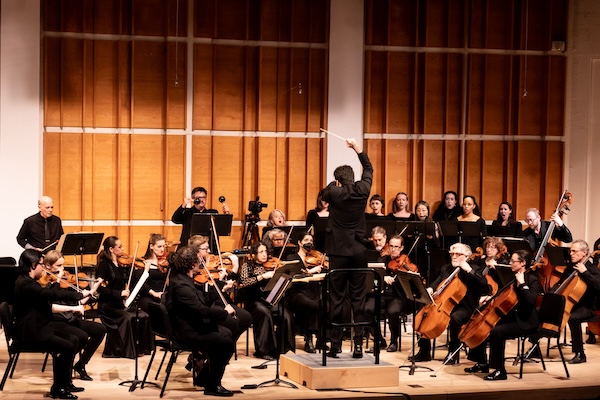Parlando movingly explores spiritual matters from Dessner to Vaughan Williams
Ian Niederhoffer and Parlando returned to Merkin Hall on Sunday afternoon for a program titled “Mystic Chords.” The theme bent towards the spiritual, with performances of three works that epitomize the eclecticism and excellence through which this ensemble has found its musical niche in New York.
Vaughan Williams’ Fantasia on a Theme of Thomas Tallis and Messiaen’s Trois Petites Liturgies de la présence divine epitomized the composers’ highly personalized connections with God. In Aheym, which means “homeward in Yiddish, Bryce Dessner explored his connection to his grandmother and an immigrant past all but lost to history.
Dessner expresses this story in a churning, forward-propelled piece for string ensemble. Niederhoffer’s emotional and intellectual connection with the music was manifested in the passion and precision that he brought to the performance. He etched its abrupt changes in musical textures, colors, and tonality with precision and clarity. The string players captured its relentlessness and mood changes in spirited, swirling dance music and pizzicati, harmonics, and other bow techniques that were punctuation marks on the musical journey.
Although the son of an Anglican clergyman, Ralph Vaughan Williams was an agnostic. His legacy, nonetheless, rests in part with his work editing the 1906 English Hymnal. In his work on the hymnal, Vaughan Williams discovered a tune by the English Renaissance composer Thomas Tallis, which inspired his Fantasia on a Theme by Thomas Tallis. Composed in 1910, it was a precursor to the composer’s pre-World War I large-scale works such as A London Symphony and The Lark Ascending.
Vaughan Williams combined lush, shimmering tones and exactly delineated, interwoven themes in the piece. Niederhoffer and his players were exemplary in the latter, imbuing the music with an austere grandeur devoid of sentimentality. Concertmaster Joel Lambdin and principal violist Gregory Williams’ solos and duets were as beautiful as they were eloquent.
Lushness and shimmer were lacking, but that was due to the hall’s size and relatively dry acoustic. Niederhoffer’s attention to detail and ability to capture the entire flowing arc of the score, however, were compensation enough.
Messiaen’s rhythmically complex, colorful, and harmonically adventurous music is rooted in mysticism and religion. He composed Trois Petites Liturgies de la présence divine for women’s chorus and orchestra in 1944, two years after his release from a Nazi prisoner-of-war camp. In addition to the music, Messiaen wrote the texts for the three movements, each describing a different facet of God’s presence.
Trois Petites Liturgies is scored for women’s voices, piano solo, onde Martenot, celesta, percussion and small string orchestra. Although religious in spirit, it was intended for concert performance. Messiaen revised it twice, eventually doubling the size of the string ensemble and the number of women’s voices. Niederhoffer used the original 1944 version, employing nine female voices and 16 string players,
In introducing the piece, Niederhoffer suggested that over 99% of the audience may have never heard an ondes Martenot. The instrument was invented in 1928 by Maurice Martenot, who sought to combine the accidental overlaps of tones between military radio oscillators and the expressiveness of the cello. Although approximately 1,000 works call for the instrument, they are seldom heard live. Niederhoffer was fortunate to have Suzanne Farrin, a leading performer and proponent of the instrument, on hand.
As with the Dessner, Messiaen’s Trois Petites Liturgies played to Niederhoffer’s strengths, albeit on a much vaster palette of texture, color, and expressiveness. It was a fascinating performance where his innate sense of structure permitted the rhythmic drive of the piece to merge seamlessly with the otherworldly atmosphere created by the ondes Martenot.
Sophiko Simsive performed the relentless solo piano part with brilliance and energy, abetted by the trio of percussionists, Andrew Beall, Bill Hayes, and Deane Prouty. Their playing was in stark contrast to the otherworldly sounds of the women’s voices and ondes Martenot. The second movement, in which Messiaen sought to capture God present in himself, swirls of sound waves created an atmosphere of joy, culminating in a triumph ring of the cymbal.
In the final movement, there was exceptionally fine playing from principal cellist Diana Golden and principal second violinist Sam Gray as well as Lambdin and Williams. The women’s voices and maracas competed with the ondes Martenot to create an all-enveloping sense of the surreal. The piece ended with an ecstatic sense of repose, at once exhilarating and calming.
Parlando presents “The Cabaret Project, Part 1” with works by Erik Satie, Franz Schreker, and William Bolcom, May 1 at Merkin Concert Hall. parlandonyc.com
